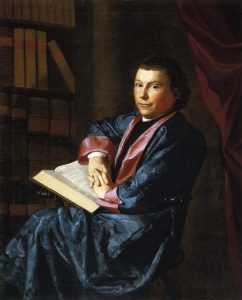
When I attended a workshop in Seattle put on by NEHGS, Lindsay Fulton told attendees that one can often find useful genealogical tidbits in old diaries, especially those written by public figures in a community. She recommended searching for diaries of anyone who lived in locations your ancestors did, even if they’re apparently unrelated to your family. You might get lucky and read about births, weddings, and deaths – and perhaps even some juicy gossip – that can flesh out your family history.
If diaries belonging to total strangers can be useful, imagine the thrill I felt when I read in the “Weekly Genealogist” of 28 March that the diary of my (half) first cousin six times removed is now available online – digitally and in transcription – through AmericanAncestors.org![1] Of course I had to dive right in, even though I had taxes to do and a belated birthday present to sew for my husband.
The diary in question is actually many volumes stretching from 1762 to 1806, excepting the year 1777. Continue reading The diary in question



